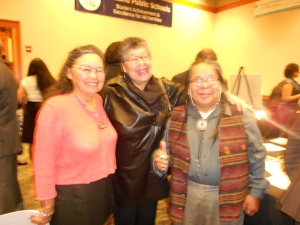At the most basic level it is a gathering of Native Americans (and non-Natives) in festivities that include drumming, singing, dancing, vendors, contests, raffles, and food... But it really is so much more than that. I guess you can kind of relate it to a giant family reunion. Every time I go to this particular powwow I get to see my cousins, my uncle, and some of the "family" that the warm community of team members and vendors has created. There are a number of vendors that I quite enjoy visiting with. I also have run the powwow at WU for the four years, and thus am very attached to the people running the powwow.
There are a few important people to note at the powwow, besides the people putting it on. They are really important, but generally easy to spot and you know their role already.
First is the Emcee. This person gives the announcements, explains what is going on, and often tells stories that enhance the attendee's experience. This person also tends to joking with those present to keep them engaged in what is going on. Not only does the Emcee tell you what is going on, they let you know when things are not allowed. Not even people putting on a powwow are allowed to photograph or record some of the special songs and dances, so please listen for when you should refrain from such things. They will also invite you to join in, so please do.
Second is the Arena Director. This person makes sure that everything on the dance floor goes according to plan, according to tradition, and makes it all run smoothly. He (or she) works in tandem with the Emcee. When the Arena Director tells you to do something, you really should listen.
Third is a group: The drummers and singers. They provide the beat that drives the entire event. One thing about Native drum-beats: they are supposed to mimic the heartbeat. I am totally serious. If you listen, you will notice your heart beats in time with the drum, your movements fall into step, and you miss the music when it stops. Listen to this song and you'll see. It is even greater at the event when the music echoes across the venue and wraps itself around you. It is quite the experience.
Four: The Dancers. This is one category I tend to fall in. These are the people wearing the fancy outfits. We call them our "Regalia," and it is like dress-up clothes for dancing. There are various categories of dancing, for both men and women. There are also "intertribal" dances, which is where you get to join in! Good thing is, no one cares if you don't know the steps, just follow along and enjoy the experience.
Five: Vendors! I tend to fall into this category. These people make amazing things! Even better than just being able to look, you can buy. Not only that, but they are willing to trade, and sometimes willing to work with you on a price. We really aren't a bad lot. I have found a lot of friends in the vendor circles, including my "Tribe in a box" family on Etsy. They have been inspirational. These people commiserate with you when there is bad, when you are sick, or when you are sad. They help bring a smile to your face as they tell you about births, weddings, sales, and good days. They always wish you the best, pray for you (if you want it/need it), and are there for you. I have found this at almost every powwow I have been to (and on my Etsy community). Here is a pic of Mother-In-Law at the booth. Her stuff is all the pretty beadwork; the baskets are mine.
 |
| A vendor at powwow who has graciously allowed me to use her photograph. |
Seven: Staff and volutneers. Yes, they are as much a part of it as anyone else. These people tend to be behind the scenes, and don't stick out as much as the other six categories. Still, without them, there would be no Powwow. They plan the location, work with the various other groups, set the place up, and clean the entire location after the event. Please take the time to thank powwow staff and volunteers when you see them. They put a lot of hard work into it.
Like the synopsis? Well, here is a powerpoint that goes a little more in-depth, and even gives a little bit of a lesson on powwow etiquette. I have used it to explain powwows to a variety of people from differing backgrounds and walks of life. It even works for people new to English (I have given this at a Japanese exchange school and they seem to understand pretty darn well.) There is a longer version that goes into the different types of dancing (feel free to email me to request a copy).
I would love to meet you at the event. Please check out this flier. I hope you can attend.
NOTE: All external sources are credited where credit is due. Thanks to Youtube and various photographers online for the video and some of the images. The powerpoint is my creation, and is linked to an upload on my other blog.
